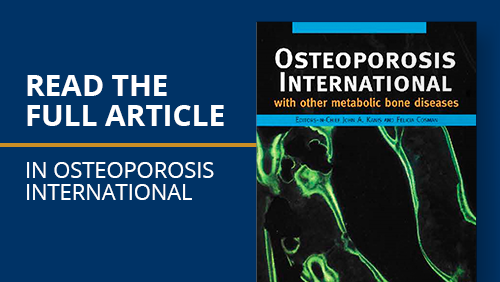LATEST NEWS
- All news
-
44Awards
-
8Burden of Osteoporosis
-
66Capture the Fracture
-
1Exercise
-
8FRAX
-
83IOF
-
31IOF Positions and Statements
-
1IOF Tour Latin America
-
20Meetings
-
56Member News
-
8Nutrition
-
35Policy
-
6Prevention
-
43Research
-
25Scientific Journals
-
13Skeletal Rare Diseases
-
7Training Courses
-
14Treatment
-
29World Osteoporosis Day
- News room - Latin America Region
Important update on use of trabecular bone score (TBS) in clinical practice

A new position paper presents an up-to-date review and expert recommendations using the GRADE methodology to inform the implementation of trabecular bone score (TBS)* in clinical practice for the management of primary and secondary osteoporosis.1
TBS is a grey-level scale textural measurement acquired from dual-energy X-ray absorptiometry lumbar spine images that correlates with bone microarchitecture and which can be used alongside FRAX and bone mineral density measurements to enhance the assessment of fracture risk and to inform treatment initiation and monitoring.
The position paper was authored by an international Expert Working Group appointed by the European Society for Clinical and Economic Aspects of Osteoporosis and Osteoarthritis (ESCEO) and the International Osteoporosis Foundation (IOF) under the auspices of the WHO Collaborating Center for Epidemiology of Musculoskeletal Health and Aging (Liège). It encompasses a comprehensive systematic review of 96 high-quality clinical studies from over 20 countries published since 2015, which provide information on the use of TBS for:
- fracture risk prediction in postmenopausal and male osteoporosis
- initiation of treatment and monitoring of treatment effect in postmenopausal osteoporosis
- prediction of fracture risk associated with secondary osteoporosis
- treatment monitoring in secondary osteoporosis
Based on the review, the experts authored 22 statements supporting the role of the TBS software in fracture risk prediction, treatment initiation and monitoring of osteoporosis. The position paper additionally incorporates a more practically focused clinician guide to the incorporation of TBS into clinical pathways for the management of osteoporosis and high fracture risk.
Professor Jean-Yves Reginster, co-author and Director of the WHO Collaborating Center for Epidemiology of Musculoskeletal Health & Aging stated: “Assessing information related to bone microarchitecture in addition to bone density and clinical risk factors provides a more complete assessment to inform management decisions for the benefit of the patient. As there has been considerable new research since the publication of our comprehensive review of TBS in 20152, we judged it was time for a systematic update of the evidence on the clinical use of TBS, via expert consensus to inform practical clinical guidance. As such we have provided a helpful appendix with concise operational guidance that facilitates the integration of TBS in clinical practice, in alignment with clinical workflow.”
Professor Nicholas Harvey, joint-senior author and Chair of the IOF Committee of Scientific Advisors, concluded: “This position paper documents the role of TBS in clinical practice, synthesising a wide range of evidence across risk assessment, treatment initiation and monitoring, in the context of postmenopausal osteoporosis, osteoporosis in men and secondary causes. The work demonstrates the value of drawing together global expertise to generate what is an evidence-based, but very practical, guide to implementation TBS in the management of osteoporosis and high fracture risk".
###
References:
1. Shevroja, E., Reginster, J-Y., Lamy, O., et al. (2023). Update on the clinical use of trabecular bone score (TBS) in the management of osteoporosis: results of an expert group meeting organized by the European Society for Clinical and Economic Aspects of Osteoporosis, Osteoarthritis and Musculoskeletal Diseases (ESCEO), and the International Osteoporosis Foundation (IOF) under the auspices of WHO Collaborating Center for Epidemiology of Musculoskeletal Health and Aging. Osteoporos Int (2023). Published online: July 01, 2023: https://link.springer.com/article/10.1007/s00198-023-06817-4
2. Harvey, N. C., Glüer, C. C., Binkley, et al. (2015). Trabecular bone score (TBS) as a new complementary approach for osteoporosis evaluation in clinical practice. Bone, 78, 216-224.
doi: 10.1016/j.bone.2015.05.016.
About IOF
The International Osteoporosis Foundation (IOF) is the world's largest nongovernmental organization dedicated to the prevention, diagnosis, and treatment of osteoporosis and related musculoskeletal diseases. IOF members, including committees of scientific researchers as well as more than 320 patient, medical and research organizations, work together to make fracture prevention and healthy mobility a worldwide heath care priority. www.osteoporosis.foundation @iofbonehealth
About ESCEO
The European Society for Clinical and Economic Aspects of Osteoporosis, Osteoarthritis and Musculoskeletal Diseases (ESCEO) is a non-profit organization, dedicated to a close interaction between clinical scientists dealing with rheumatic disorders, pharmaceutical industry developing new compounds in this field, regulators responsible for the registration of such drugs and health policy makers, to integrate the management of osteoporosis and osteoarthritis within the comprehensive perspective of health resources utilization. The objective of ESCEO is to provide practitioners with the latest clinical and economic information, allowing them to organize their daily practice, in an evidence-based medicine perspective, with a cost-conscious perception. www.esceo.org @esceo
* TBS iNsight™ (Osteo) is a medical image processing device seamlessly integrated into dual-energy X-ray absorptiometry (DXA) scanners, and/or X-rays and CT PACs systems, used to measure BMD to detect bone fragility. The software provides deep tech bone texture analysis related to bone micro-architecture and complements BMD measuring and clinical risk factors to refine the management of osteoporosis without further examination or radiation. It is commercially available in 60 countries worldwide and benefits from dedicated reimbursement CPT codes in the USA.
The software is a product of Medimaps Group which is a partner to the Pre-Competitive Consortium on Osteoporosis and Bone Health (PRECCO), a consortium of corporate partners supporting the 5-year partnership between WHO, IOF and ESCEO. These corporate partners place the well-being of osteoporotic patients above their immediate strategy, in terms of content and timelines.